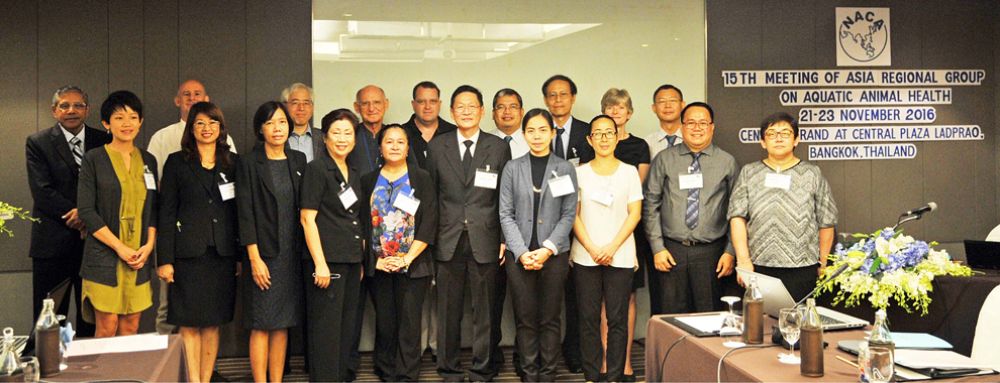15th meeting of the Asia Regional Advisory Group on Aquatic Animal Health
25 November 2016 | 4092 views | China, Crabs and lobsters, Freshwater finfish, Governance and Policy, Health and Biosecurity, India, Indonesia, Inland aquaculture, Iran, Malaysia, Marine finfish, Markets and trade, Molluscs (shellfish and other), Philippines, Shrimp, Sri Lanka, Thailand

The advisory group was established in 2001 to provide advice to member governments on aquatic animal health management. The activities of the group include evaluating disease trends and emerging threats in the region; identifying developments in global aquatic animal disease issues and standards of importance to the region; reviewing the regional aquatic animal disease reporting system and to provide guidance on strategies to improve aquatic animal health. The group is the linchpin of a regional network of experts, research centres and reference laboratories.
The 15th meeting was held from 21-23 November 2016, in Bangkok, Thailand. Members of the group include invited aquatic animal disease experts, representatives of the World Organisation for Animal Health (OIE) and the Food and Agriculture Organization of the United Nations (FAO) and collaborating centres such as the SEAFDEC Aquaculture Department. Dr Melba Reantaso (FAO) was selected as the incoming chair, relieving Dr Kjersti Gravningen (Aquafuture, Norway) who had served as Chair from 2014-2015. Highlights of discussions are summarised below.
Over the past year NACA had completed a project on development of a Code of Practice for the Trans-boundary Movement of Aquatic Organisms in the Lower Mekong Basin, for the Mekong River Commission. The code was developed in consultation with the fisheries line agencies of MRC member countries, with additional input via national surveys and a regional consultation workshop. The final draft of the code is available for download from the NACA website.
FAO had initiated and progressed some technical cooperation projects on aquatic animal health. These included:
- Development of preventative aquatic animal health protection plan and enhancing emergency response capacities to shrimp disease outbreaks in Indonesia (new).
- Strengthening aquaculture biosecurity capacity of Malaysia’s Department of Fisheries (new).
- Strengthening biosecurity capacity of Palau (new).
- Development of a national strategy for aquatic animal health, in the Federated States of Micronesia (new).
- Acute hepatopancreatic necrosis disease (ongoing), involving India, Iran, Philippines and Sri Lanka.
- Infectious myonecrosis virus (ongoing), involving china, Indonesia and Thailand.
FAO had also initiated several donor funded projects including on aquaculture certification (funded by the EU), antimicrobial resistance (funded by USAID) and on preparation of the Fiji National Aquatic Biosecurity and Aquatic Animal Health Strategy (funded by JICA).
The Aquaculture Department of the Southeast Asian Fisheries Development Center (SEAFDEC AQD) had conducted twelve in-house studies in 2016. These were aimed to i) investigate the efficacy of probiotics and rationalise use of diagnostics, ii) to promote the wider use of conventional and new diagnostic methodologies, iii) find safe and effective alternatives to use of drugs and chemicals in aquaculture and iv) to increase the capacity of fish health specialists in fish disease diagnosis using gross clinical examination, bacteriology, mycology, parasitology and histopathology techniques.
The newly formed Aquatic Animal Health Research and Development Division of the Thai Department of Fisheries had been established from 1 October 2016 from the former Inland Aquatic Animal Health Research Institute and Coastal Aquatic Animal Health Research Institute. The new division would assume responsibility for approval of fish farm standards for the import and export of live aquatic animals, surveillance and monitoring programmes for OIE-listed diseases in wild and farmed populations, issuance of health certificates and provision of diagnostic services for farmers.
A special session was held on addressing the use of anti-microbial substances in aquaculture and the development of anti-microbial resistance. This is an issue of global concern for both human and animal health, and it had been addressed by a resolution at FAO’s Thirty-ninth Conference in June 2015. FAO had developed an Action Plan on Antimicrobial Resistance, which would address awareness, development of capacity for surveillance and monitoring of resistance, governance related to prudent use of antimicrobial substances in food and agriculture and promote good practices. The plan would support the World Health Organization-led Global Action Plan on Antimicrobial Resistance, highlighting the necessity of adopting a “One Health” approach involving cooperation between human and veterinary health authorities, the food and agriculture sectors and consumers.
A regional projected funded by USAID and coordinated by FAO had been commissioned Addressing Antimicrobial Usage in Asia’s Livestock, Aquaculture and Crop Production Systems. The project aimed to promote a more prudent use of antimicrobial substances in livestock industries and the crop production sector to minimise the development and spread of resistance. The project will document antimicrobial usage and resistance in livestock industries including aquaculture, improve awareness of impacts and best practices, establish a platform for the promotion of antimicrobial stewardship in Asia and strengthen capacity in surveillance and monitoring.
The meeting reviewed in detail the status of aquatic animal disease in the region. Issues included:
- Developments in acute hepatopancreatic necrosis disease (AHPND) and hepatopancreatic microsporidiosis (HPM) of shrimp, caused by Enterocytozoon hepatopenaei.
- Reports of tilapia lake virus (now confirmed – Ed.) in Thailand and Streptococcus outbreaks affecting tilapia.
- A detailed analysis of amphibian and molluscan diseases in the region, including the impact of chytrid fungus, which had recently been found could be hosted by crayfish (Procambarus spp.) which could transmit the pathogen to amphibians.
For full details of the technical sessions please download the report of the meeting.
Creative Commons Attribution.